So, you want to build enterprise software for your business but you don’t know how? And it sounds overwhelming?
Don’t worry, you’re in the right place.
In this article, we’ll discuss the 6 best practices you should follow to make enterprise software development a breeze.
Let’s dive in!
What is enterprise software development?
Let’s cover the basics first – what is enterprise software development?
Enterprise software development is the process of developing software that’s built to meet the needs of large businesses and organizations rather than individual users.
But, what does that mean, exactly?
Enterprise software is used to manage various tasks and processes within an organization, such as managing customer relationships or payment processing:
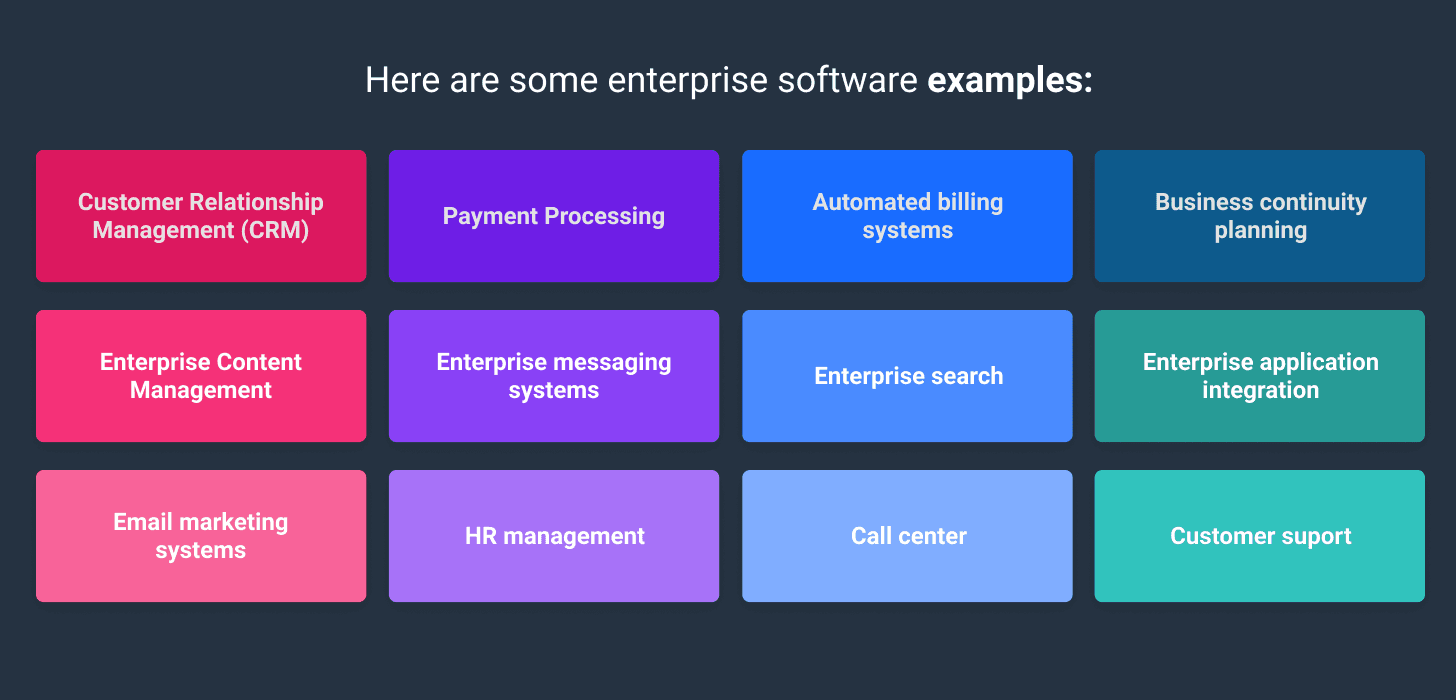
It’s a massive market, too, worth an estimated $292 billion in 2024.
There’s a good reason for that – enterprise software improves your organization’s operational efficiency and helps you better manage your data.

With it, you’ll have all of your business-critical data in one place.
And this will improve your decision-making and make it much easier to keep your entire team on the same page.
But, you need to do it right – here are the key qualities of great enterprise software:
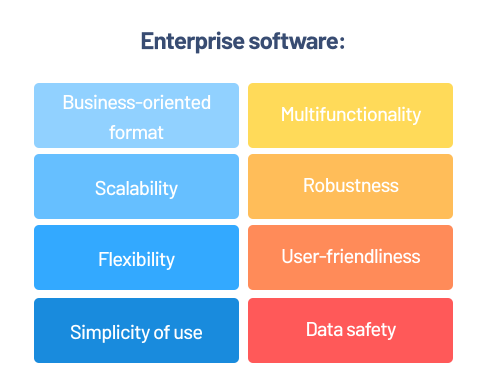
So, your goal when building enterprise software is to create a user-friendly, simple to use product that can manage complex tasks – easy, right?
If you do it right, it can be – we’ll now show you how to do just that.
6 enterprise software development best practices
Here, we’ll cover the 6 best practices you should follow when building enterprise software.
Write detailed requirements first
Would you start building a house without a blueprint?
Of course you wouldn’t – and you shouldn’t build enterprise software without writing detailed requirements first, either.
Your software requirements specification (SRS) document is just like a blueprint – it should show everything you need to actually build your product.
So, what should your SRS cover?
Keep in mind that every SRS document is unique, but these are the key components you should include:
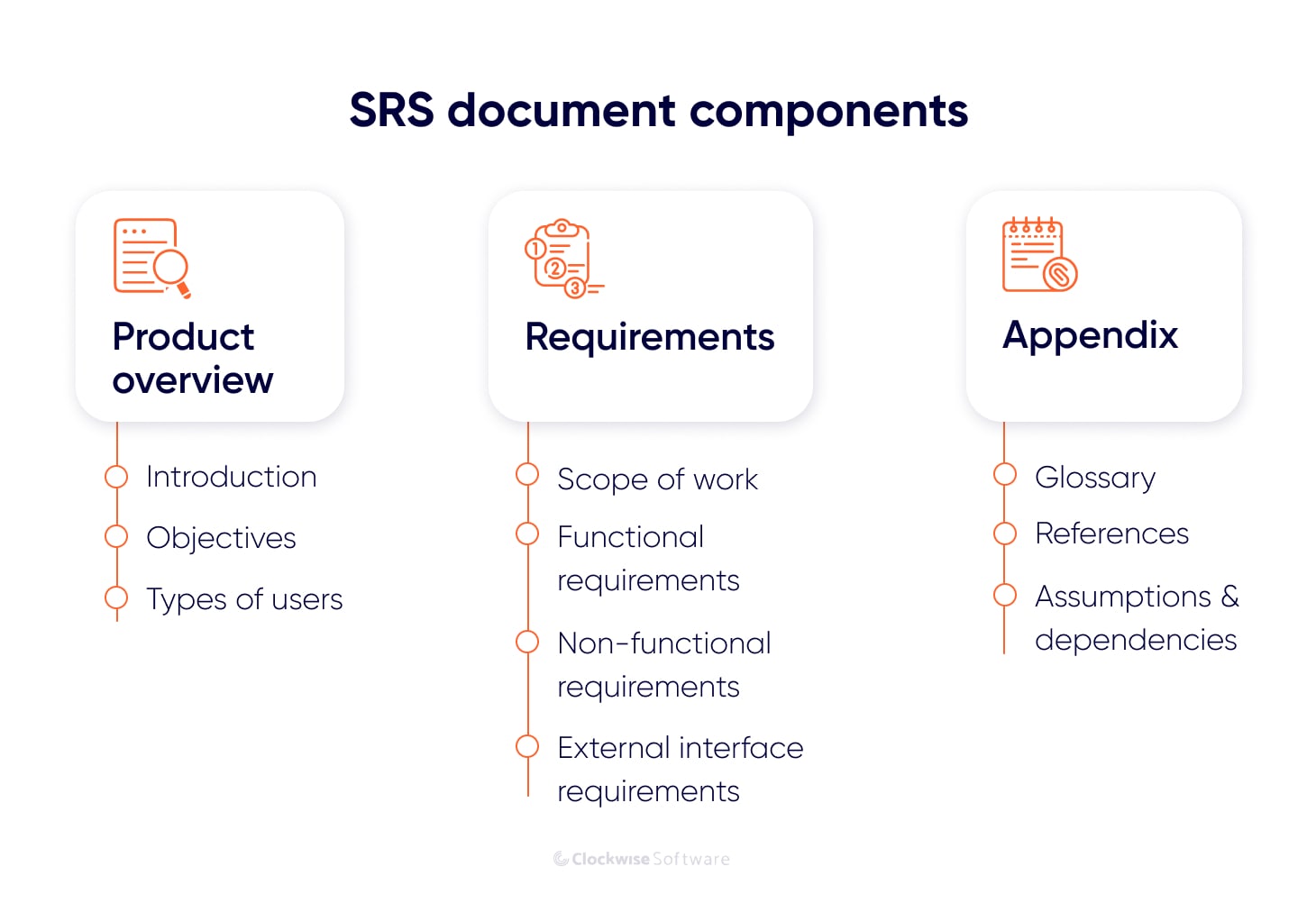
source: Clockwise Software
But, the 2 most important are the functional and non-functional requirements.
Simply put, your product’s functional requirements cover what it does and non-functional requirements cover how it does it.
Functional requirements focus on and describe your product’s features and functionalities, while non-functional requirements describe specific performance and security metrics.
Here’s a detailed breakdown of both:

Having detailed requirements is especially important when you’re building enterprise software.
Enterprise software is more complex to build than consumer-facing software, so the risks are higher, too.
And detailed requirements will help you identify potential issues early and avoid scope creep.
Also, you’ll be able to better plan development, which will save you both time and money.
And that’s exactly what you should be looking for.
What you should avoid
- Ambiguity – your requirements should be clear and easy to understand, because vague requirements lead to misunderstandings and delays
- Not involving stakeholders – you should involve key stakeholders in the requirements-gathering process, so the product you build actually meets your business needs
- Skipping validation – before you start development, you need to validate your requirements with stakeholders to make sure they’re relevant and accurate
Use Agile methodologies
How you approach development is just as important as the type of software product you’re building – enterprise software development is no exception.
And Agile methodologies are the way to go if you want to successfully build your product.
The stats back that up, too – on average, Agile projects are 28% more successful than projects using traditional methodologies.
And that’s because Agile methodologies share 3 key attributes:
- Iteration
- Collaboration
- Flexibility
Also, Agile teams are cross-functional by design, which comes with its own set of benefits:

source: Quixy
On top of that, since quality assurance (QA) and testing are a key part of every Agile methodology, they’re a better choice from a business perspective, too.
“Scrum, for example, is proven to detect defects faster than any waterfall methodology. Detecting problems early translates into money saved.”
And with how complex enterprise software usually is, these savings can be huge.
But, which methodologies are out there? And how do you pick the right one?
The top Agile methodologies out there are:
- Scrum
- Kanban
- Lean Software Development
- Extreme Programming (XP)
- Feature-Driven Development (FDD)
Picking the right one depends on a number of factors, from your product’s requirements to your team’s size and expertise.
But, overall, Scrum is the best fit for most projects – 81% of Agile teams use Scrum or a Scrum hybrid.
It’s simple, too – Scrum breaks down your development cycle into 2-4 week iterations called sprints.

Each sprint is like a mini development cycle and includes everything from planning to launch.
This approach is very useful when building complex enterprise software for 2 reasons – faster development and flexibility.
So, if you need to pivot mid-development or have a tight deadline, Scrum is a great choice.
What you should avoid
- Rigid processes – you shouldn’t follow Agile processes to the letter, because flexibility is key if you have to respond to changes mid-development
- Neglecting training – if they’re not already familiar with Agile methodologies, make sure you train your team before implementing them
- Skipping documentation – although Agile methodologies emphasize building working software over thorough documentation, you should still have documentation to make maintenance and future scaling easier
Focus on security
Security is key when you’re building enterprise software.
The enterprise software you build will handle confidential, business-critical data – and it’s a prime target for cyberattacks.
And cybercrime is on the rise in recent years:
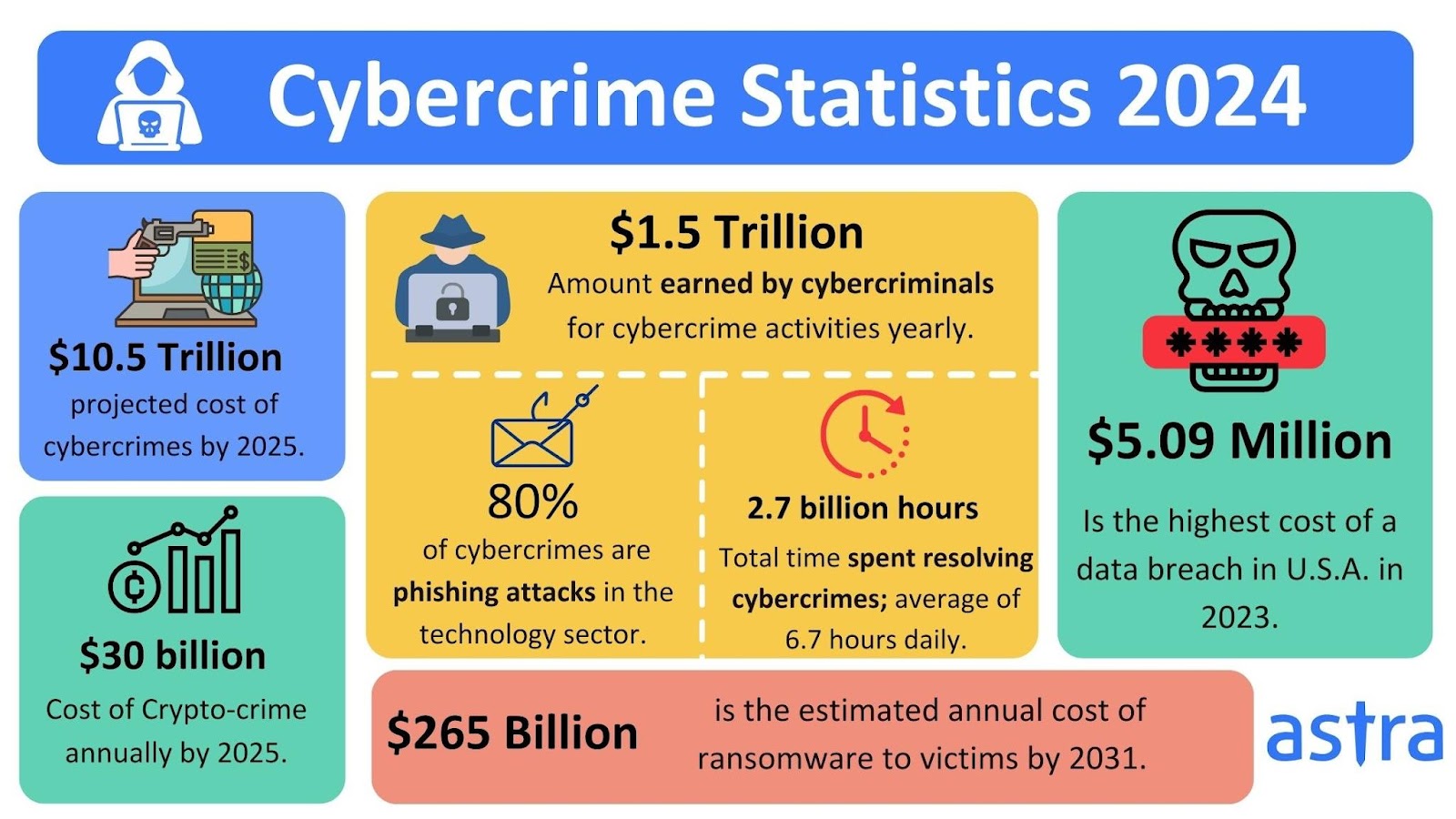
source: Astra Security
Here’s another eye-watering statistic – in 2023, the average cost of a data breach reached a record high of $4.45 million.
And if a data breach does happen, the financial cost is just the tip of the iceberg.
You also risk severe reputational damage – 60% of companies end up going out of business after a severe data breach.
So, investing in security is an absolute must – here’s what you should do:
- Do regular security audits
- Use strong encryption methods
- Implement multi-factor authentication (MFA)
But, that’s just the start.
If you want to be one step ahead of any would-be attacker, it’s a good idea to invest in AI cybersecurity systems like Darktrace or Crowdstrike’s Falcon platform.
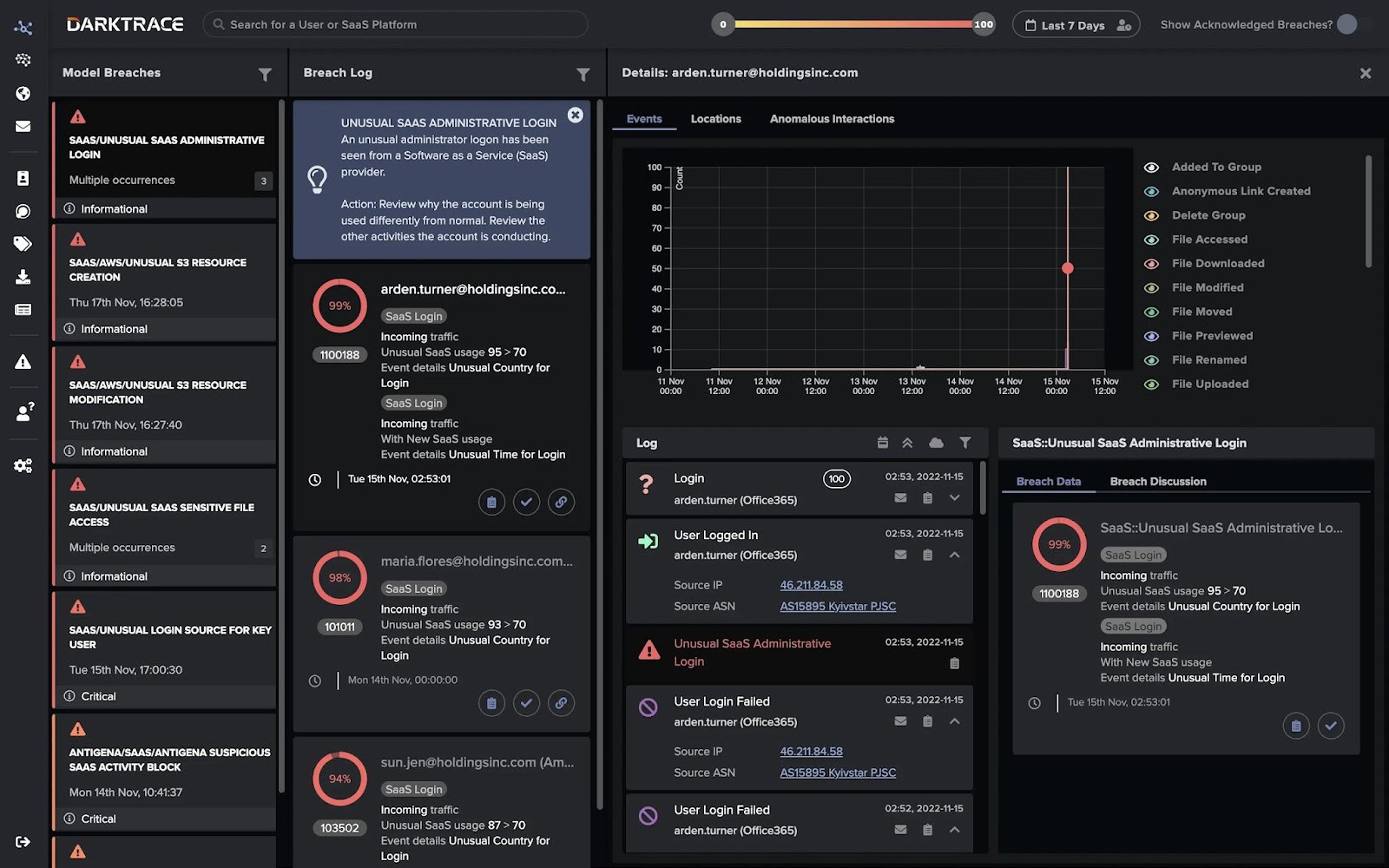
source: Darktrace
They both offer end-to-end protection and integrate a huge number of different cybersecurity tools in one place.
And the best part?
Since they use AI, they learn after each encounter with a potential threat, becoming better and better over time.
And that’s why they’re a good investment.
What you should avoid
- Neglecting regular updates – outdated software is vulnerable to attacks, so make sure to have regular security updates and patches
- Weak password policies – strong, complex passwords and regular password changes are key for security
- Skipping employee training – human error one of the top reasons for security breaches, so employee training on security best practices is essential to minimize risk
Ensure scalability
Ensuring scalability is essential when you’re building enterprise software.
As your business grows, your enterprise software needs to keep up – scalability is key to making that happen.
It means your software can handle more users and higher data volumes without a drop in performance.
And it can scale horizontally and vertically, depending on your needs:
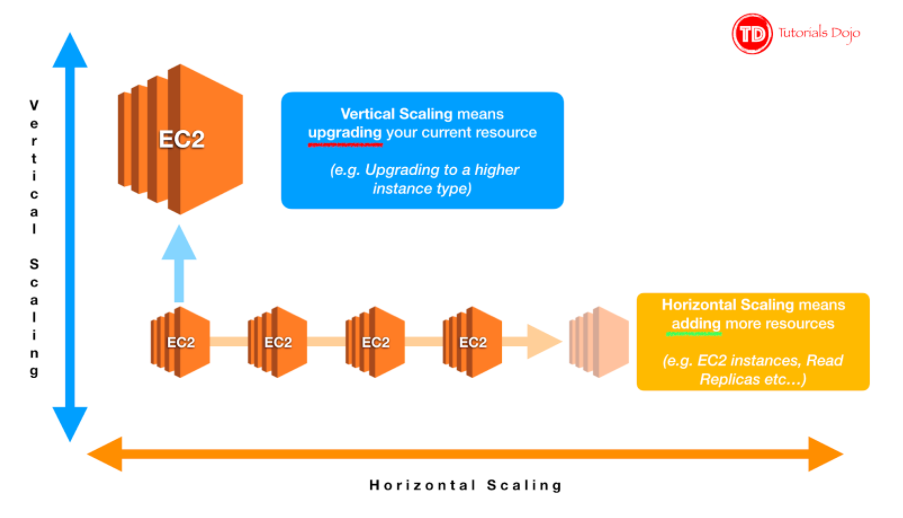
source: Tutorial Dojo
If your enterprise software is scalable from the start, it will be able to meet your needs if your business starts rapidly growing.
So, how do you build a scalable software product?
Here are some key steps you should follow:

source: Kanda Software
But, 2 of these elements stand out – cloud computing services and your product’s architecture.
Cloud services are key to having a scalable product.
They can automatically scale resources up or down, based on demand – and they’re cost-effective, too.
They operate on a pay-as-you-go model, so you only pay for the resources you actually use, and you won’t have to invest in expensive hardware infrastructure.
Some of the top ones you should use are:
Your product’s architecture is just as important – you should build your product with modular, microservices-based architecture.
This way, you’ll be able to scale individual parts of the system without affecting the rest.
And that’s the way to go if you want scalable software.
What you should avoid
- Monolithic architecture – monolithic architecture is much harder to scale than modular, microservices-based architecture
- Short-term solutions – don’t implement solutions that only meet your current needs, planning for future growth is key to long-term scalability
- Ignoring performance testing – performance testing ensures your software can handle increased loads and data volumes without drops in performance, which is crucial for scalability
Integrate QA from the start
Investing in QA is one of the best things you can do when building enterprise software.
And integrating it from the start is even better.
If you don’t, it can cost you a fortune – poor software quality costs U.S. companies $2.42 trillion every year.
And if you start testing early, you’ll save even more money – the sooner you detect a bug, the cheaper it is to fix:
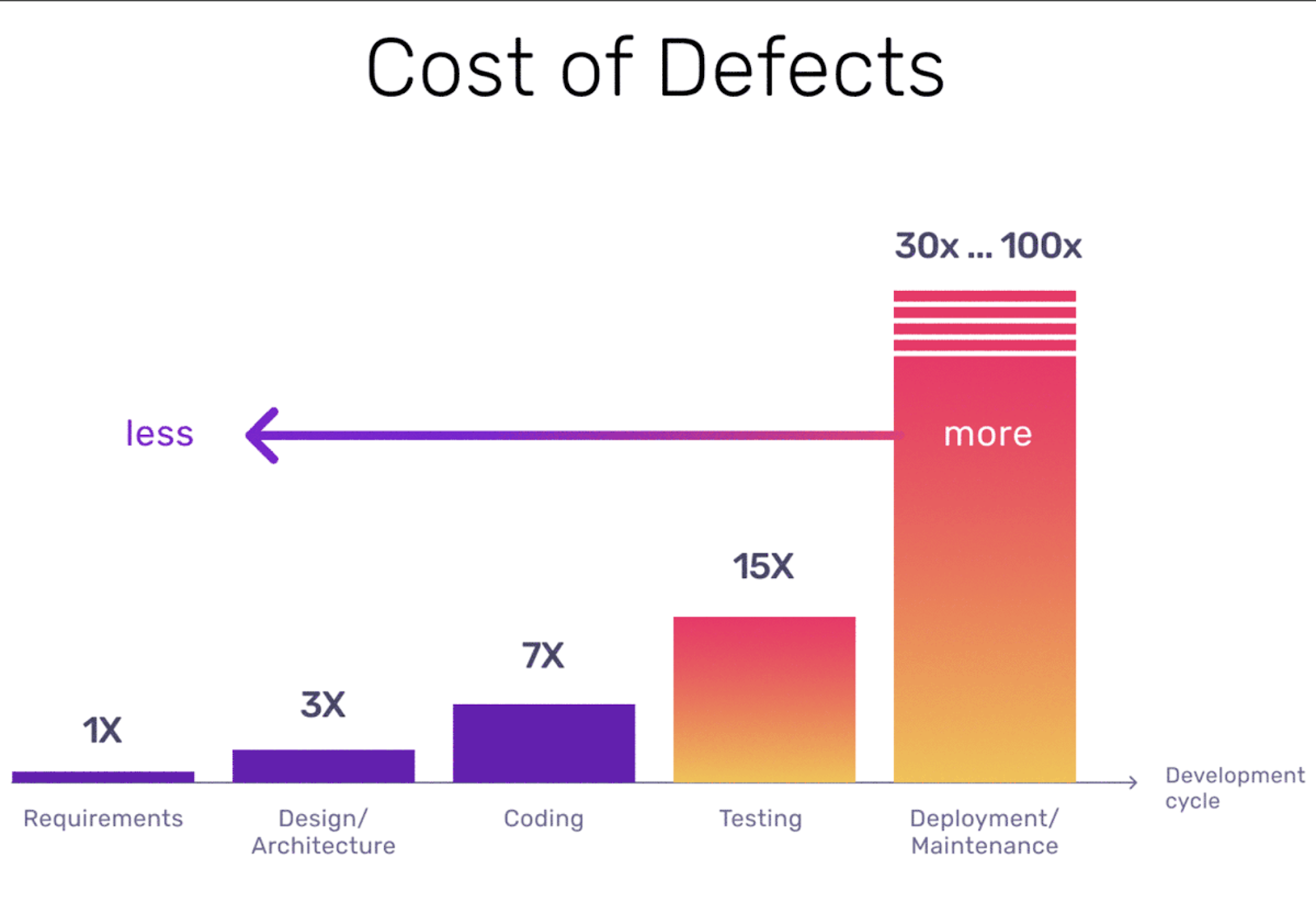
source: Functionize
When you discover a defect after deployment, it can be up to a 100 times more expensive to fix than if you found it when writing your requirements.
So, how do you make sure you’re doing QA right?
For starters, you need to make sure your QA team has a detailed testing strategy.
With it in place, they’ll have an easier time planning individual tests and they’ll be more efficient.
Also, make sure they use a variety of testing methods like:
- Unit testing
- Integration testing
- Performance testing
- Security testing
- Regression testing
- Load testing
This way, you’ll cover all angles and make sure your enterprise software actually meets quality standards and your business needs.
And that’s key to its successful development.
What you should avoid
- Manual-only testing – you should use a mix of manual and automated testing, which will both make your testing more efficient and improve your test coverage
- Isolated QA teams – if you want testing to be effective, your QA teams should work closely with your engineering teams
- Limited test coverage – you need to make sure your tests cover edge cases and less obvious scenarios as well as standard scenarios
Choose the right development partner
Outsourcing enterprise software development is a no-brainer if you want to speed up development and save money.
But, you need to get it right – and that means choosing the right company to partner with.
70% of companies that outsource development do it because they save money on development.
And there’s a good reason for that – outsourced development is up to 53% cheaper than in-house development:
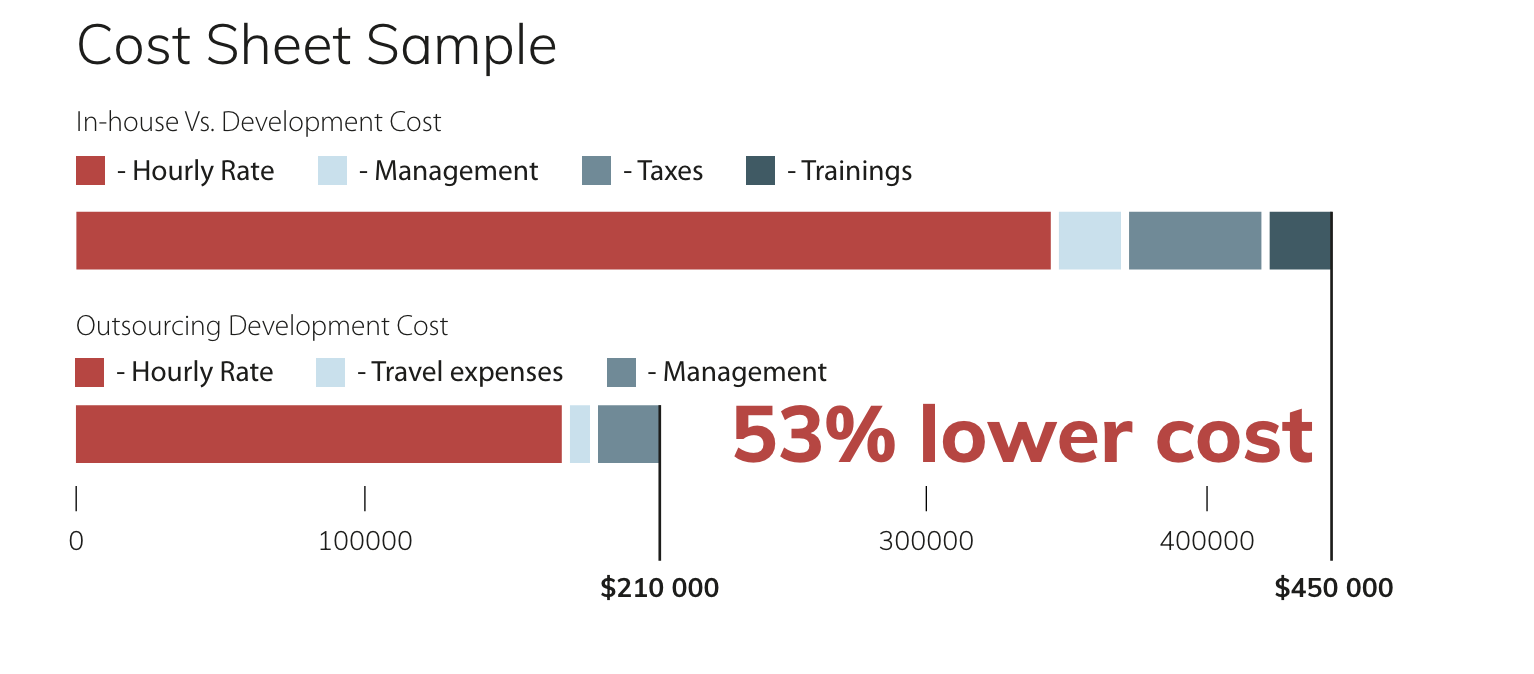
source: Existek
But, there’s more to outsourcing than just cost reduction.
If you outsource, you can:
- Get access to a global talent pool
- Speed up development
- Easily scale the team up or down based on your needs
So, how do you pick the right vendor to partner with?
Here’s what you should do when picking a development partner:
- Read their case studies
- Check their reviews
- Evaluate their tech stack
- Review their approach to development
- Look into their pricing
But, the most important thing is reading their case studies and their reviews.
Let’s say you want to build an internal communication app.
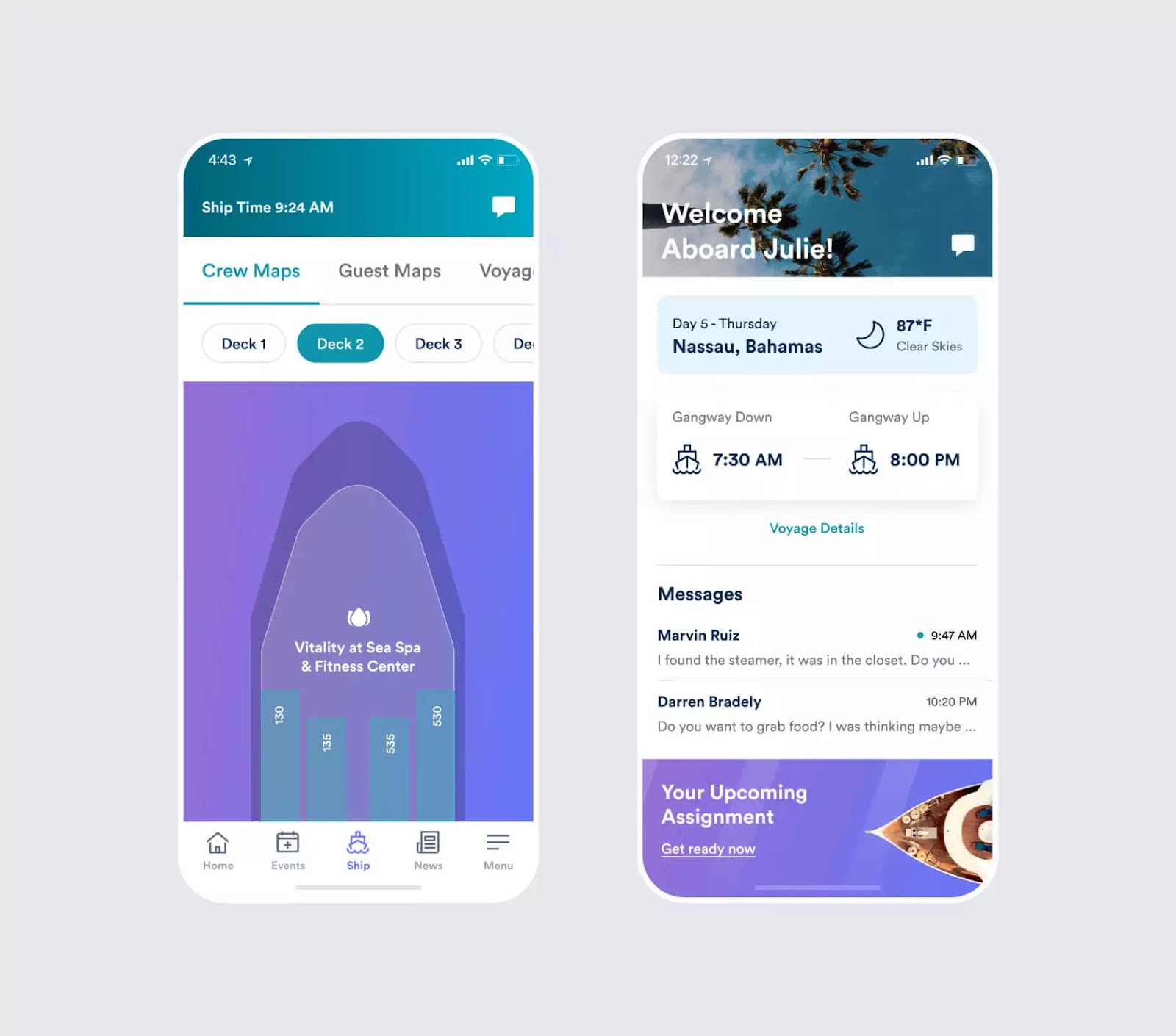
Their case studies will show you if they have experience building similar apps i.e. if they have the needed expertise – that’s an absolute must when building complex enterprise software.
On the other hand, their reviews will show you what it’s actually like to work with them, beyond the self-serving buzzwords you find on their site.
Reading them will help you find a company that’s both easy to work with and has the chops to build your enterprise software.
And that’s exactly what you should be looking for in a development partner.
What you should avoid
- Rushing the process – you should take time to evaluate if a company has the right experience and is the right fit for your project before committing
- Ignoring cultural fit – if you don’t have a cultural fit with your development partner, it can lead to communication issues and conflicts
- Choosing based on price alone – price is just one piece of the puzzle when choosing a vendor and quality, reliability, and expertise are much more important in the long run
Enterprise software development best practices: FAQs
What is enterprise software?
Enterprise software is software that’s built to meet the needs of large businesses and organizations rather than individual users.
What are the stages of enterprise software development?
The stages of enterprise software development are:
- Product discovery
- Product design
- Software engineering
- Continual product improvements
Here’s what that looks like in more detail:
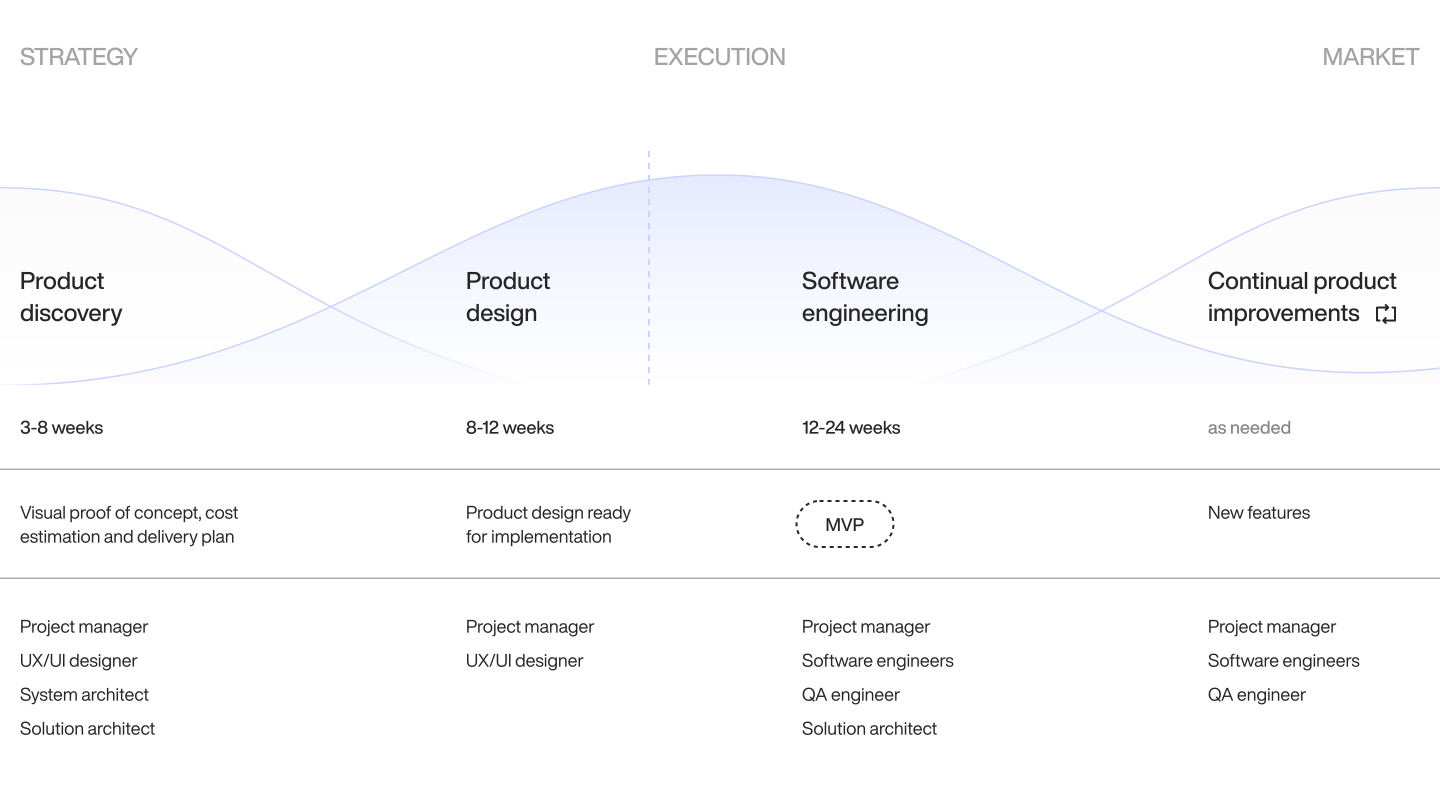
Which programming language is best for enterprise software development?
There’s no simple, definitive answer to which programming language is best suited for enterprise software development. But, here are some top languages you should use and when they’re a good fit:
- Java – back-end, server-side development
- C# – if you use the .NET and rely on Windows-based infrastructure
- Kotlin – native Android development
- Dart – cross-platform mobile development, if you use Flutter
- JavaScript – front-end and mobile app development
- Swift – native iOS development
Need help building your enterprise software?
Do you have an interesting enterprise software project in the works but haven’t found the right partner yet?
We’ve got you covered.
We can help you build it from the ground up – from validating your idea all the way to post-launch maintenance and updates.
If you want to learn more, feel free to reach out and we can set up a quick chat to discuss your needs in more detail.



